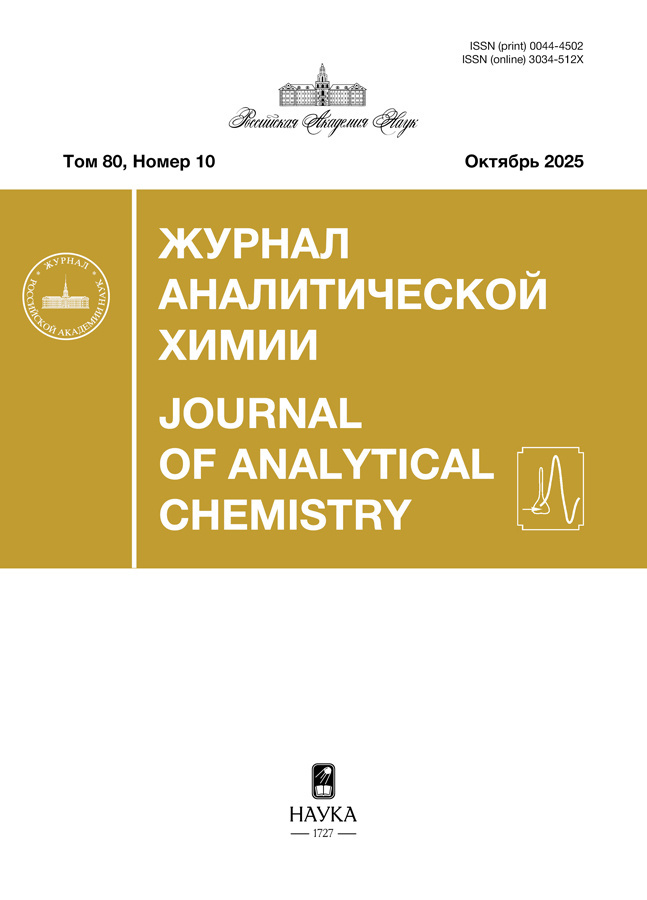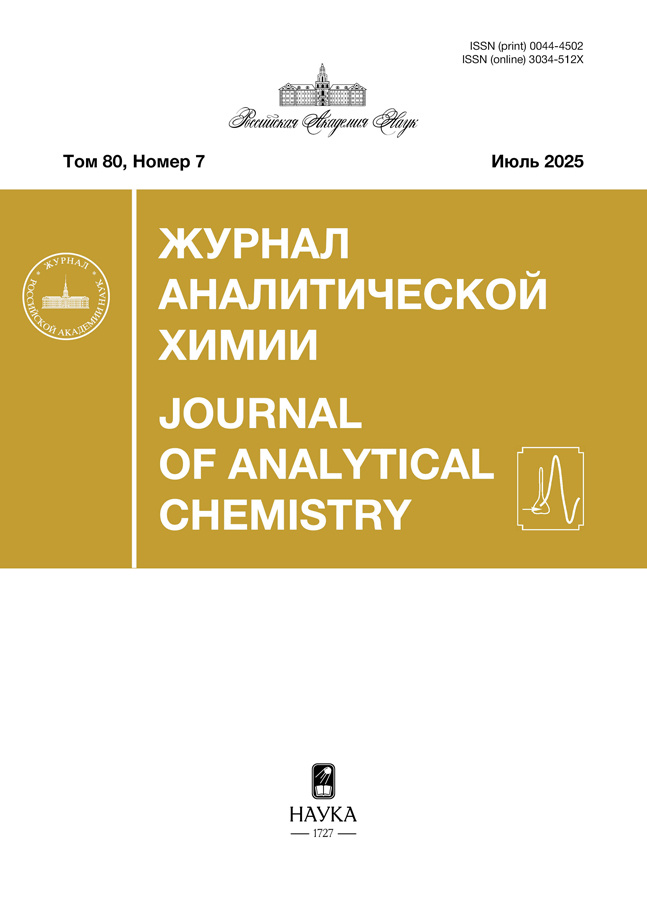New micellar polymers as polyfunctional modifiers of electrophoretic systems
- Authors: Adamova A.A.1, Potapenko D.A.1, Fetin P.A.1, Kartsova L.A.1
-
Affiliations:
- Saint Petersburg State University
- Issue: Vol 80, No 7 (2025)
- Pages: 745-755
- Section: ORIGINAL ARTICLES
- Submitted: 19.07.2025
- Accepted: 19.07.2025
- URL: https://cardiosomatics.orscience.ru/0044-4502/article/view/687910
- DOI: https://doi.org/10.31857/S0044450225070094
- EDN: https://elibrary.ru/biechc
- ID: 687910
Cite item
Abstract
New modifiers of electrophoretic systems – cationic polyelectrolytes with micellar properties poly-11-acryloyloyloxyundecyl-N-methylpiperidinium bromide (pAUMP-Br), poly-11-acryloyloxyundecylpyridinium bromide, poly-11-acryloyloxyundecyl-1,4-diazobicyclo[2. 2.2.2.2]octan-1-ium bromide and a chiral copolymer based on acylated quinine and N-(11-acryloyloyloyloxyundecyl)-N-methylpiperidinium bromide (pAUMP-AQin). The electrophoretic capabilities of these polymers were studied in the separation of model mixtures of biologically active substances: steroid hormones, biogenic amines and amino acids in the modes of micellar electrokinetic chromatography and capillary electrochromatography. It was found that new polyelectrolytes are polyfunctional modifiers of quartz capillary walls and background electrolyte and allow to realize different modes of electrophoretic separation of biologically active substances, indirect detection in the presence of chromophoric group in the polymer composition, generate anodic electroosmotic flow, influence the efficiency and selectivity of analytes separation. Field-amplified sample stacking was performed on a quartz capillary modified with pAUMP-Br, providing a 15-fold concentration of biogenic amines and lowering the detection limits. The chiral labeled pAUMP-AQin copolymer was found to facilitate the separation of tryptophan enantiomers.
Full Text
About the authors
A. A. Adamova
Saint Petersburg State University
Author for correspondence.
Email: st117588@student.spbu.ru
Russian Federation, Saint-Petersburg
D. A. Potapenko
Saint Petersburg State University
Email: st117588@student.spbu.ru
Russian Federation, Saint-Petersburg
P. A. Fetin
Saint Petersburg State University
Email: st117588@student.spbu.ru
Russian Federation, Saint-Petersburg
L. A. Kartsova
Saint Petersburg State University
Email: st117588@student.spbu.ru
Russian Federation, Saint-Petersburg
References
- Wang M., Gong Q., Liu W., Tan S., Xiao J., Chen C. Applications of capillary electrophoresis in the fields of environmental, pharmaceutical, clinical, and food analysis (2019–2021) // J. Sep. Sci. 2022. V. 45. № 11. P. 1918.
- Kolobova E., Kartsova L., Kravchenko A., Bessonova E. Imidazolium ionic liquids as dynamic and covalent modifiers of electrophoretic systems for determination of catecholamines // Talanta. 2018. V. 188. P. 183.
- Kravchenko A., Kolobova E., Kartsova L. Multifunction covalent coatings for separation of amino acids, biogenic amines, steroid hormones, and ketoprofen enantiomers by capillary electrophoresis and capillary electrochromatography // Sep. Sci. Plus. 2020. V. 3. № 4. P. 102.
- Карцова Л.А., Макеева Д.В., Бессонова Е.А. Современное состояние метода капиллярного электрофореза // Журн. аналит. химии. 2020. Т. 75. № 12. С. 1497. (Kartsova L.A., Makeeva D.V., Bessonova E.A. Current status of capillary electrophoresis // J. Anal. Chem. 2020. V. 75. № 12. P. 1497.)
- Li Y., Miao S., Tan J., Zhan, Q., Chen D.D.Y. Capillary electrophoresis: A three-year literature review // Anal. Chem. 2024. V. 96. № 20. P. 7799.
- Corradini D. Buffering agents and additives for the background electrolyte solutions used for peptide and protein capillary zone electrophoresis // TrAC, Trends Anal. Chem. 2023. V. 164. Article 117080.
- Ali I., Suhail M., Locatelli M., Ali S., Y. Aboul-Enein H. Role of ionic liquids in capillary electrophoresis // Analytica. 2022. V. 3. № 2. P. 236.
- Zhang Q., Xue S., Li A., Ren S. Functional materials in chiral capillary electrophoresis // Coord. Chem. Rev. 2021. V. 445. Article 214108.
- Konášová R., Butnariu M., Šolínová V., Kašička V., Koval D. Covalent cationic copolymer coatings allowing tunable electroosmotic flow for optimization of capillary electrophoretic separations // Anal. Chim. Acta. 2021. V. 1178. Article 338789.
- Šolínová V., Tůma P., Butnariu M., Kašička V., Koval D. Covalent anionic copolymer coatings with tunable electroosmotic flow for optimization of capillary electrophoretic separations // Electrophoresis. 2022. V. 43. № 20. P. 1953.
- Dzema D., Kartsova L., Kapizova D., Appelhans D. New approach to the formation of physically adsorbed capillary coatings consisting of hyperbranched poly (ethylene imine) with a maltose shell to enhance the separation of catecholamines and proteins in CE // Chromatographia. 2017. V. 80. P. 1683.
- Поликарпова Д.А., Макеева Д.В., Карцова Л.А., Даванков В.А., Павлова Л.А. Поли-4-винилпиридиниевые наногубки в качестве модификаторов электрофоретических систем для разделения заряженных аналитов // Аналитика и контроль. 2019. T. 23. № 3. С. 343.
- Wang B., Ni X., Yu M., Cao Y. Polymeric micelle as the pseudostationary phase in electrokinetic chromatography // J. Chromatogr. A. 2012. V. 1245. P. 190.
- Roca S., Dhellemmes L., Leclercq L., Cottet H. Polyelectrolyte multilayers in capillary electrophoresis // ChemPlusChem. 2022. V. 87. № 4. Article e202200028.
- Qi L., Qiao J. Advances in stimuli-responsive polymeric coatings for open-tubular capillary electrochromatography // J. Chromatogr. A. 2022. V. 1670. Article 462957.
- Horvath J., Dolník V. Polymer wall coatings for capillary electrophoresis // Electrophoresis. 2001. V. 22. № 4. P. 644.
- Xu S., Wang Y., Li W., Ji Y. Covalent organic framework incorporated chiral polymer monoliths for capillary electrochromatography // J. Chromatogr. A. 2019. V. 1602. P. 481.
- Wu J., Xiao X., Li Z., Jia L. Enantioseparation of chiral β-blockers using polynorepinephrine-coated nanoparticles and chiral capillary electrophoresis // Anal. Bioanal. Chem. 2019. V. 411. P. 2121.
- Makeeva D., Morgacheva V., Kolobova E., Solovyeva E., Kartsova L. Multilayer coatings based on gold nanoparticles and polymers with bovine serum albumin as a functional layer for the chiral separation in capillary electrochromatography // J. Sep. Sci. 2024. V. 47. № 2. Article 2300864.
- Catai J.R., Toraño J.S., de Jong G.J., Somsen G.W. Efficient and highly reproducible capillary electrophoresis–mass spectrometry of peptides using Polybrene – poly (vinyl sulfonate) – coated capillaries // Electrophoresis. 2006. V. 27. № 11. P. 2091.
- Maráková K., Opetová M., Tomašovský R. Capillary electrophoresis-mass spectrometry for intact protein analysis: Pharmaceutical and biomedical applications (2018–March 2023) // J. Sep. Sci. 2023. V. 46. № 15. Article 2300244.
- Карцова Л.А., Кравченко А.В., Колобова Е.А. Ковалентные покрытия кварцевых капилляров для электрофоретического определения биологически активных аналитов // Журн. аналит. химии. 2019. Т. 74. № 8. С. 563. (Kartsova L.A., Kravchenko A.V., Kolobova E.A. Covalent coatings of quartz capillaries for the electrophoretic determination of biologically active analytes // J. Anal. Chem. 2019. V. 74. № 8. P. 563.)
- Hajba L., Guttman A. Recent advances in column coatings for capillary electrophoresis of proteins // TrAC, Trends Anal. Chem. 2017. V. 90. P. 38.
- Znaleziona J., Petr J., Knob R., Maier V., Ševčík J. Dynamic coating agents in CE // Chromatographia. 2008. V. 67. P. 5.
- Malburet C., Leclercq L., Cotte J.F., Thiebaud J., Cottet H. Separation of three strains of polio virus by capillary zone electrophoresis and study of their interaction with aluminum oxyhydroxide // J. Chromatogr. A. 2022. V. 1667. Article 462838.
- Liu Q., Lin F., Hartwick R.A. Poly (diallyldimethylammonium chloride) as a cationic coating for capillary electrophoresis // J. Chromatogr. Sci. 1997. V. 35. № 3. P. 126.
- Hamidli N., Pajaziti B., Andrási M., Nagy C., Gáspár A. Determination of human insulin and its six therapeutic analogues by capillary electrophoresis-mass spectrometry // J. Chromatogr. A. 2022. V. 1678. Article 463351.
- Salzer L., Stolz A., Dhellemmes L., Höchsmann A., Leclercq L., Cottet H., Neusüß C. Successive multiple ionic-polymer layer coatings for intact protein analysis by capillary zone electrophoresis–mass spectrometry: Application to hemoglobin analysis / Capillary Electrophoresis-Mass Spectrometry: Methods and Protocols. Methods in Molecular Biology. V. 2531. New York, NY: Humana, 2022. P. 69.
- Cordova E., Gao J., Whitesides G.M. Noncovalent polycationic coatings for capillaries in capillary electrophoresis of proteins // Anal. Chem. 1997. V. 69. № 7. P. 1370.
- Gao T., Li X., Jia Z., Hendrickx F., Falmagne J.B., Chen H.X. Rapid capillary zone electrophoresis of recombinant erythropoietin by the use of dynamic double layer coating // Anal. Lett. 2020. V. 53. № 16. P. 2596.
- Zhou C., Deng J., Shi G., Zhou T. β-Сyclodextrin-ionic liquid polymer based dynamically coating for simultaneous determination of tetracyclines by capillary electrophoresis // Electrophoresis. 2017. V. 38. № 7. P. 1060.
- Al Azzam K.M. A novel and simple dynamic coating capillary electrophoresis method for the chiral separation and quantification of mitiglinide enantiomers using hydroxyethyl cellulose as a dynamic coating agent // Die Pharmazie – Int. J. Pharm. Sci. 2022. V. 77. № 3–4. P. 95.
- Jia Y., Cao J., Zhou J., Zhou P. Methyl chitosan coating for glycoform analysis of glycoproteins by capillary electrophoresis // Electrophoresis. 2020. V. 41. № 9. P. 729.
- Sepehrifar R., Boysen R.I., Danylec B., Yang Y., Saito K., Hearn M.T. Application of pH-responsive poly (2-dimethyl-aminoethylmethacrylate)-block-poly (acrylic acid) coatings for the open-tubular capillary electrochromatographic analysis of acidic and basic compounds // Anal. Chim. Acta. 2016. V. 917. P. 117.
- Ali N., Qiao J., Qi L. Preparation of pH-responsive block copolymers for separation of cephalosporin antibiotics by open-tubular capillary electrochromatography // J. Chromatogr. A. 2023. V. 1694. Article 463926.
- Sui Z., Schlenoff J.B. Controlling electroosmotic flow in microchannels with pH-responsive polyelectrolyte multilayers // Langmuir. 2003. V. 19. № 19. P. 7829.
- Liu J.X., Zhao M.Z., Deng Y., Tie C., Chen H.X., Zhou Y.L., Zhang X.X. The coating of smart pH-responsive polyelectrolyte brushes in capillary and its application in CE // Electrophoresis. 2013. V. 34. № 9-10. P. 1352.
- Fuguet E., Ràfol, C., Bosch E., Abraham M.H., Rosés M. Selectivity of single, mixed, and modified pseudostationary phases in electrokinetic chromatography // Electrophoresis. 2006. V. 27. № 10. P. 1900.
- Dzema D., Kartsova L., Emelianov G. Highly fluorinated polymers with sulfonate, sulfamide and N, N-diethylamino groups for the capillary electromigration separation of proteins and steroid hormones // J. Sep. Sci. 2017. V. 40. № 16. P. 3335.
- Fetin P.A., Lezov A.A., Fetina V.I., Kadnikov M.V., Tsvetkov N.V., Zorin I.M. Comb-like polyelectrolytes–New surfactants with controlled solubilization capacity // J. Mol. Liq. 2022. V. 357. Article 119085.
- Adamova A.A., Orlov M.S., Rakovskaya N.S., Fetin P.A., Kartsova L.A. New Comb-Like Polyelectrolytes in Capillary Electrophoresis // Chromatographia. 2024. V. 88. P. 1.
- Lämmerhofer M., Lindner W. Chiral stationary phases derived from Cinchona alkaloids / Chiral Separations and Stereochemical Elucidation: Fundamentals, Methods, and Applications. Hoboken, New Jersey, U.S.: John Wiley & Sons, Inc., 2023. P. 415.
- Zhou H., Chen J., Li H., Quan K., Zhang Y., Qiu H. Imidazolium ionic liquid-enhanced poly (quinine)-modified silica as a new multi-mode chromatographic stationary phase for separation of achiral and chiral compounds // Talanta. 2020. V. 211. Article 120743.
Supplementary files




















